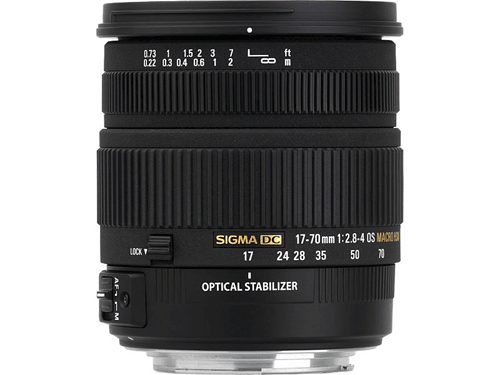Sigma 17-70mm f/2.8-4 DC Macro OS HSM
 |
| Gary Wolstenholme takes a look at Sigma's 17-70mm lens with optical stabilisation. |
Sigma's 17-70mm lenses have been a popular upgrade for people wishing to move up from the standard 18-55mm kit lenses. The latest make over costs around £330 and includes a silent focusing motor and optical stabilisation and still retains a similar close focusing ability like its predecessor. Those looking at alternatives may also consider the original version of this lens, which only costs around £250 but sacrifices the silent focusing motor and optical stabilisation.
Canon users have an alternative in the EF-S 17-85mm f/4-5.6 IS USM, which costs around £360 and sacrifices a stop of brightness throughout the zoom range, but adds 15mm to the telephoto end of the range.
Nikon users have the 18-105mm AF-S DX ED VR lens to choose from, which again offers a slightly extended telephoto reach, but sacrifices one millimetre from the wide end and only costs a rather cheap £230.
The closest match in terms of specification from Sony's range is the 16-80mm f/3.5-4.5 ZA VS T* DT, which comes at a premium price of £619 due to the Carl Zeiss branding and has a slightly longer zoom range but lacks optical stabilisation and is half a stop slower throughout the range.
Pentax also do a 17-70mm lens. Theirs has a constant maximum aperture of f/4 and a silent motor, but lack optical image stabilisation and costs around £460.
Overall this Sigma lens seems to stack up well against the competition, offering a brighter maximum aperture for a competitive price.
Sigma 17-70mm f/2.8-4 DC Macro OS HSM: Handling and features
Being only 88.9mm long and with a diameter of 79mm, this lens is reasonably compact for a a lens sporting an f/2.8 aperture at the wide end. It only weighs 520g too, which should suit those who travel a lot quite well. The lens barrel is constructed from high quality black plastics and some parts have a matt powder finish to them. This powder finish tends to mark over time, even with light use, but looks quite smart when the lens is new.
The control layout matches that of pretty much every other recent Sigma lens covering this range, with a focus ring around the front of the lens and a wider rubberised zoom ring closer to the camera body. The zoom mechanism is smooth and doesn't tighten up at any point in the range. The lens extends in two sections at maximum zoom, adding a couple of inches to the length. Focusing is performed internally, but there is no way to disengage the focus ring during AF. As a result I tended to catch my fingers on the focus ring as it moves back and forth during autofocus. Focus isn't as fast as other lenses in this range I've tested, but the performance is adequate for most people's requirements.
The lens accepts 72mm filters and as the front element does not rotate during focus or zoom actions, it is more suitable for use with polarisers and neutral density graduated filters.
Sigma's Optical Stabiliser promises to allow sharp shots to be taken at shutter speeds up to four stops slower than would be possible otherwise. I was able to take a sharp shot about half the time at 1/6sec and 70mm, which is roughly four stops slower than the usual rule of thumb would recommend. Increasing the shutter speed to 1/13sec bagged me a sharp shot with much more consistency.
Sigma 17-70mm f/2.8-4 DC Macro OS HSM: Performance
The old version of this lens has an excellent reputation for the image quality it can deliver, and this lens builds on that. At 17mm, the resolution in the centre is already excellent and the quality towards the edges isn't too shabby either. Peak quality is achieved at f/4, where the resolution in the centre is outstanding, and it approaches very good levels towards the edges.
At 35mm, it is much the same story, with excellent resolution in the centre and good sharpness towards the edges. Peak quality is actually achieved at maximum aperture, which is impressive.
Finally at 70mm the overall level of sharpness drops off a little. At f/4 the quality across the frame is still very good and peak quality across the frame is achieved at f/5.6. Overall this is superb performance for a lens costing a shade over £300.
Throughout the zoom range chromatic aberrations are kept below acceptable levels, just reaching a level of 0.7 pixel widths towards the edges at 17mm and f/2.8. This level should only really be visible along high contrast edges towards the edge of the frame.
Falloff of illumination towards the corners is pretty well controlled. At 17mm and f/2.8, the corners are 1.41stops darker than the image centre and visual uniformity is achieved at f/4. At 70mm the level of falloff decreases to only 1.05 stops, and images appear visually uniform at f/5.6.
Barrel distortion at 17mm is quite prominent. Here Imatest recorded 5.05% barrelling. At 70mm the barrel distortion is replaced with mild pincushion distortion. Here Imatest recorded a value of 0.934%. If straight lines are paramount you'll be pleased to know that the distortion pattern is uniform across the frame, making it simple to correct in image editing software afterwards.
When shooting into the light a little flare is possible, mainly at 17mm and occasionally a noticeable loss of contrast will occur at 70mm. A petal shaped lens hood is supplied, which does an excellent job of shielding the front element from extraneous light which may cause issues with light sources outside of the frame.
 | DxOMark provides objective, independent, RAW-based image quality performance data for lenses and digital cameras to help you select the best equipment to meet your photographic needs. Visit the DxOMark website for tests performed on the Sigma 50mm f/1.4 EX DG HSM. |
Sigma 17-70mm f/2.8-4 DC Macro OS HSM: Verdict
Well where do I start? Sigma seem to have pulled out all the stops for this lens. Not only is it capable of producing images with excellent sharpness, but the zoom range is very useful, as is the close focusing ability and the optical stabilisation. The build quality is good for a £330 lens too.
There are a couple of minor niggles with the lens, such as the focus ring rotating during autofocus, but to be honest these are only minor issues. In terms of performance for the price, this lens is superb!
 |
| A great all-round lens at a great price. |
 Excellent optical performance
Excellent optical performance Decent build quality
Decent build quality Effective optical stabiliser
Effective optical stabiliser Close focus ability
Close focus abilitySigma 17-70mm f/2.8-4 DC Macro OS HSM: Cons
 Focus ring cannot be disengaged during AF
Focus ring cannot be disengaged during AF| FEATURES |  |
| HANDLING |  |
| PERFORMANCE |  |
| VALUE FOR MONEY |  |
| OVERALL |  |
Sigma 17-70mm f/2.8-4 DC Macro OS HSM: Lens specification
| Price | £330.00 |
| Contact | www.sigma-imaging-uk.com |
| Filter size | 72mm |
| Format | APS-C |
| Construction | 17 elements in 13 groups |
| Angle-of-view | 72.4° - 20.2° |
| 35mm equivalent focal length (on APS-C body) | 25.5-105mm |
| Internal focusing | Yes |
| Image stabilisation | Yes |
| Minimum focus | 28cm |
| Maximum aperture | f/2.8-4 |
| Minimum aperture | f/22-32 |
| Weight | 520g |
| Size | 79mm x 88.9mm |
| In the box | Lens Case, Lens Hood |
The Sigma 17-70mm f/2.8-4 DC Macro OS HSM costs around £330 and is available from Warehouse Express for Canon here:
Sigma 17-70mm f/2.8-4 DC Macro OS HSM for Canon
Sigma 17-70mm f/2.8-4 DC Macro OS HSM for Nikon
Sigma 17-70mm f/2.8-4 DC Macro OS HSM for Pentax
Sigma 17-70mm f/2.8-4 DC Macro OS HSM for Sigma
Sigma 17-70mm f/2.8-4 DC Macro OS HSM for Sony
Add your message
Login required
Please login here or if you've not registered, you can register here. Registering is safe, quick and free.
Please login here or if you've not registered, you can register here. Registering is safe, quick and free.
photodo Stats
1102 lenses
428 MTF tests
74 in-depth photodo reviews
100+ users join each day
Help the lens community by reviewing or rating a lens today via our lens search
428 MTF tests
74 in-depth photodo reviews
100+ users join each day
Help the lens community by reviewing or rating a lens today via our lens search
Latest Lens Reviews
- Chinon 28mm f/2.8 Vintage Lens Review
- Canon EF 70-200mm f/4L IS II USM Lens Review
- Samyang AF 85mm f/1.4 EF Review
- Sigma 70mm f/2.8 DG Macro Art Review
- Samyang AF 24mm f/2.8 FE Review
- Meike 50mm f/1.7 Review
- Tamron 70-210mm f/4 Di VC USD Review
- Lensbaby Burnside 35mm f/2.8 Review
- Asahi Super Takumar 50mm f/1.4 Review
- Asahi Super-Multi-Coated Takumar 135mm f/3.5 Review









